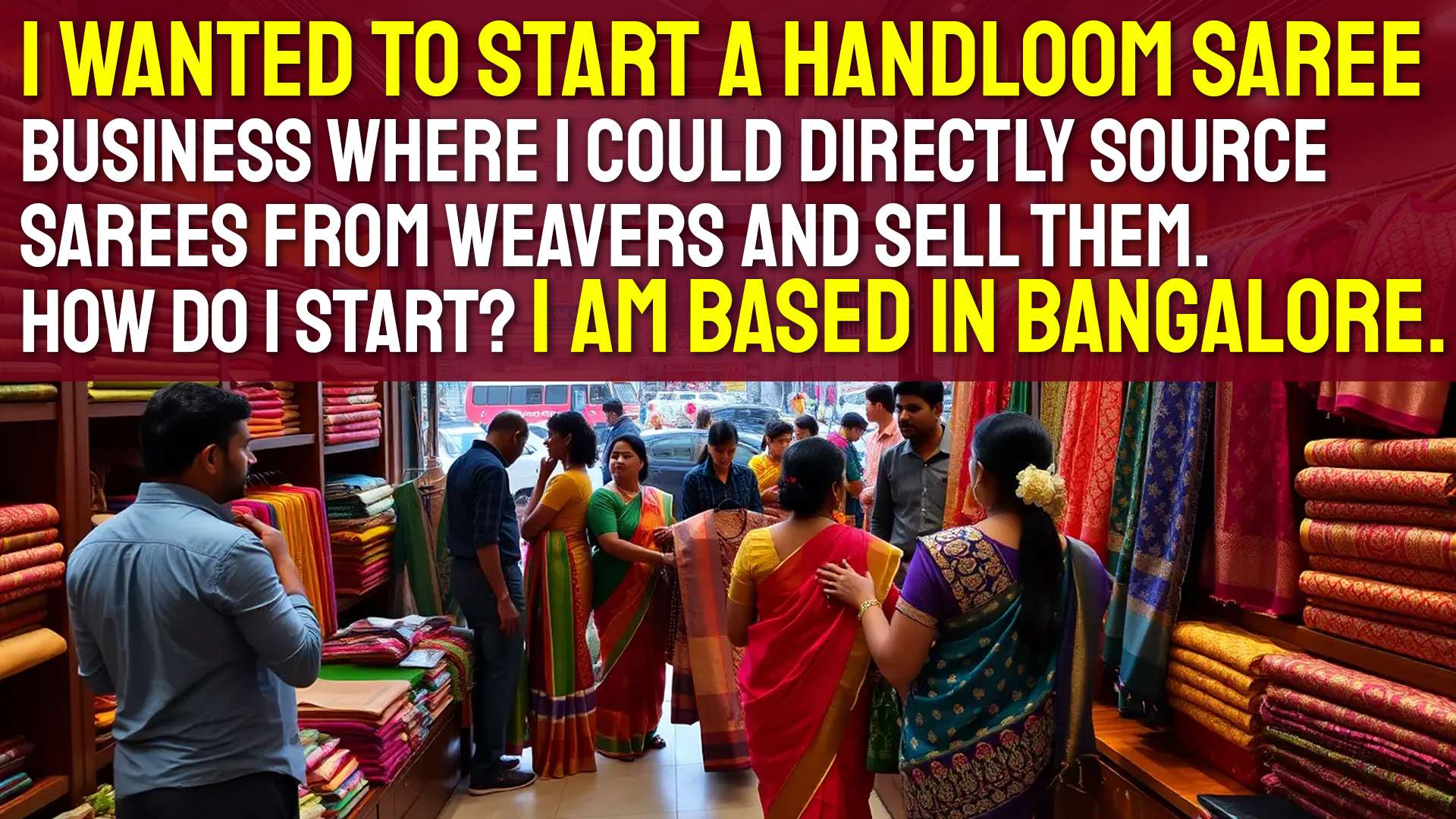I wanted to start a handloom saree business where I could directly source sarees from weavers and sell them. How do I start? I am based in Bangalore.

Share Blog:
Weaving Your Dream: Setting Up Handloom Saree Business in Bangalore
Bangalore is a city with a confluence of cultures and opportunities. It is an ideal place to set up your handloom saree business. The handloom saree is a product of woven fabric with a distinctive appeal and a rich history.
Tying up with weavers and customers who appreciate this distinctive product allows you to advance this craft while making money, and in the future, you could potentially enhance the development of this niche market.
This article outlines the steps for a successful handloom saree business startup in Bangalore:
1. Formulate Business Goals and Identify Customers
-
Vision: Imagine what aspects are to make your business successful. For instance, would you have a chain of sarees of a particular region, or would you be designing both ethnic and modern works, or would you have a certain price point?
-
Target Audience: Who are you selling to? Are you aiming at young women who are stylish yet are pampered or are you focusing on the masses? Knowing who will be your client pool will allow you to select the exact breeches and marketing plans you’ll need.

2. Research and Sourcing
-
Explore Weavers & Communities: The art of handloom weaving is not something that has just erupted in today’s time, it has been in style for generations. Study the traditional weaving society in different regions of India, especially those where the type of saree you want to manufacture is widespread. Useful information may be available from government websites, for example, the Department of Handlooms & Textiles.
-
Direct Sourcing: Building rapport with weavers begins with contacting them directly or visiting the weaving centers. Search for weavers cooperatives and government-led programs advocating hand loom weaving as they can help you find good suppliers.
-
Quality Control: There are a number of steps implemented in order to maintain the garb’s credibility and the hand sarees that you sell are fabricated with precision.
3. Business Legalities and Registration
-
Sole Proprietorship or Partnership: In either case, whether it’s about being a sole proprietor or a partnership with another person, you must register yourself accordingly with where your business is based.
-
GST Registration: For the goods and services tax (GST) use a GST as a big Department, where you should have your business registration. There can be some changes on the registration limit so make sure to review the legislation in place.
-
Trade License: To ensure that your business is conducted legally, it is vital to secure a trade license from a competent municipal corporation.
4. Working on Brand Identity
-
Brand Name and Logo: Come up with a memorable brand name and design a logo that clearly identifies who you are and what you do.
-
Website and online presence: Make a Makh Lakhan users-friendly website where both special features and saree pictures are linked in a certain way. Further, look into Ajio Myntra and other e-commerce sites or build your own on selling sarees.
-
Social Media Marketing: Consider joining social platforms such as Instagram and Facebook, and use them to post images about your sarees, your weavers, and potential customers.
5. Operations and Logistics
Inventory Management: Start with a fitting inventory, based on your potential investment and potential sales, so as not to over-stretch your storage space. Make sure you strike a good balance in supporting customer requirements.
Payment Gateway: Incorporate a protected payment gateway within the online interface you require for a business.
-
Delivery and Shipping: So, what do you have in mind for delivery? Doing the delivery on your own, or preferring a good courier service? Make sure your customers are fully aware about the shipping costs and delivery timelines.

For Franchisee Inquiry, Call: +9163521 77288
The Ajmera Fashion Advantage:
Ajmera Fashion’s chief goal is to promote and protect handloom fabrics which includes handlooms Geo-Promotions. While we will not be purchasing from the weavers in this particular case, we would select those garments who appreciate the beauty of handloom fabric.
How Can We Support Your Handloom Saree Business?
-
Marketing and Brand Building: From our practice, understand how to develop a fashion brand that bears a stamp of success. Perhaps you could work with Ajmera Fashion so that your sarees are marketed out more with the assistance of our advertising networks.
-
Customer service: Insights into the importance of customer service delivery in generating trust in customers, thus enhancing loyalty, will be useful.
If your handloom saree business in Bangalore is starting up, it's great already the combination of entrepreneurship and the love of the sacred culture. It is important to know how to combine all this and through very accurate sourcing, build up your brand assertion, turning the dream into reality.

For Wholsale Inquiry, Call: +916358907210
Also read: Why is Clothing Franchise Business Popular In India.
General FAQs concerning Starting a Business:
Q: How Much Capital is Needed to Launch a Handloom Saree Business?
A: Capital requirement depends on the level at which one wants to operate. Other things like the inventory, the domain for the website, marketing, and other operational expenditures come into play. It's advisable to start at a lower level and expand progressively.
Q: Is it necessary to have a physical shop, or can I sell sarees via an online business?
A: There is no need to have a physical store at the beginning only because this would increase the initial expenditure. A brick-and-mortar location is needed for considering the future when some progress has been made in business.
Q: What are the legal formalities to incorporate to set up a business in Bangalore?
A: The business has to be registered (sole proprietorship, type of business, etc), there is a need to acquire GSR registration, and finally a trade license from the municipal office concerned.
Q: How does one run the inventory for a saree business? Specifically on sarees in stock how do you proceed?
A: As for inventory, begin building from a reasonable base and then use suitable inventory management software or spreadsheets to track your stock levels. This includes different aspects like the type of saree, its fabric, color, and pricing range.
Q: Where should I look for handloom weavers in India?
A: There are handloom weaving centers in Andhra Pradesh, Telangana, Karnataka, Tamil Nadu, West Bengal and Odisha. Check government websites and brochure shows to find the weavers.
Q: How do I verify that the sarees are handloom?
A: Hints of hand loom weaving such as inconspicuous variation of the weave, selvage (edges), and to some extent use of natural fibers in the weave can serve as proof. It is best to buy from the handloom cooperatives or master weavers to be sure of authenticity.

For Franchisee Enquiry, Call: +9163521 77288
Also Read...





